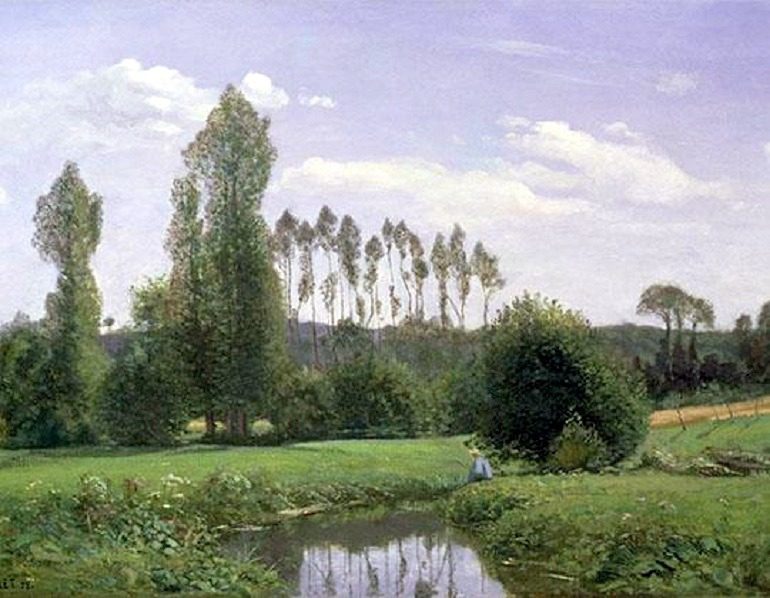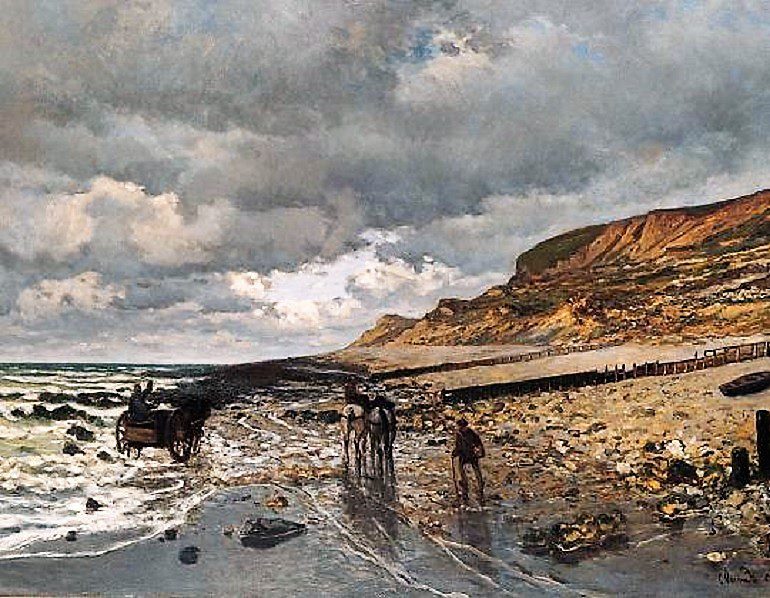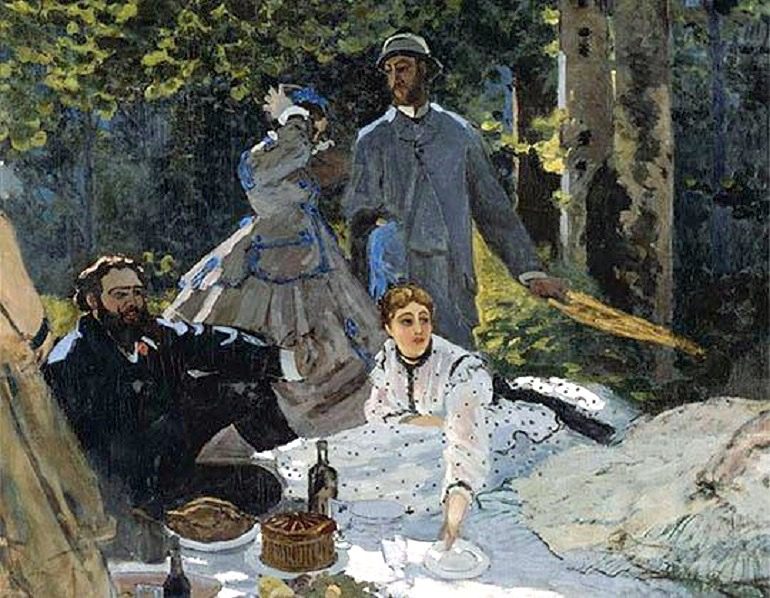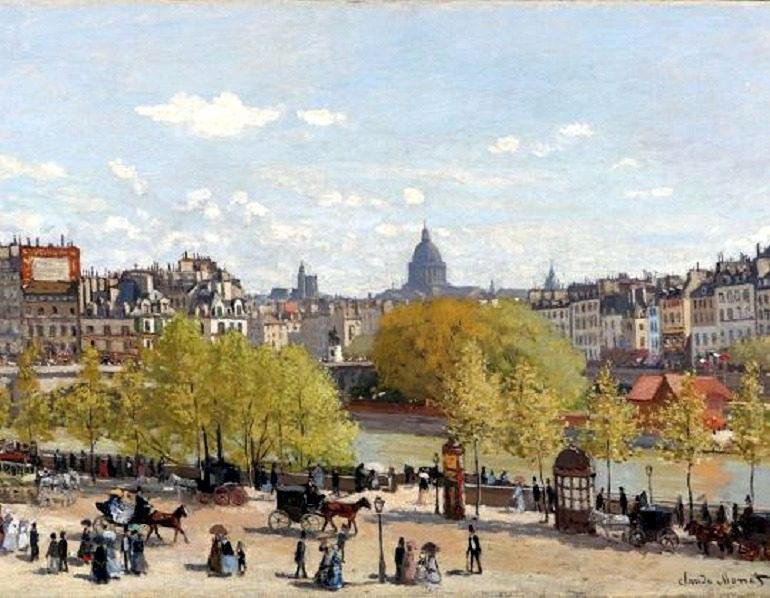ART NEWS
Adolphe Monet Reading in a Garden, an oil on canvas painting by Claude Monet on display at Kimbell Art Museum in Monet: The Early Years. Image: Kimbell Art Museum
REVIEW | ART
A new art exhibition at the Kimbell Art Museum shows that Claude Monet was a rebellious artist who surmounted many obstacles on his way to success.
BY KAZAD
Claude Monet Early Years: From Unknown Artist to a Celebrity

Claude Monet, Le Nain View Near Rouelles 1858. Oil on canvas painting from Claude Monet Early Years. Marunuma Art Park. Image: Kimbell Art Museum
FORT WORTH, TEXAS — With the number of exhibitions about Claude Monet and the impressionists happening in museums across the globe, it is easy to overlook the show at the Kimbell Art Museum. Titled Monet: The Early Years, this important exhibition deserves every attention because it is the first show to focus on Monet’s early years. The show starts from his Normandy debut in 1858 until 1872.
The show brings context to many of the works created during the first phase of the artist’s career. Organized in conjunction with the Fine Arts Museums of San Francisco, this show has so much relevance that one can draw a connection from it to many other exhibitions on Claude Monet and the impressionists happening across the globe.
Organized in conjunction with the Fine Arts Museums of San Francisco, this show has so much relevance that one can draw a connection from it to many other exhibitions on Claude Monet and the impressionists happening across the globe.
Claude Monet Paintings
Many of the paintings in Monet: The Early Years are from museums in the United States, Europe, and Japan. The curatorial approach for this show is chronological. The exhibition follows four major trajectories in the artist’s early career: Monet Before the Public, Monet and His Family, A Painter of Water and Reflection, and A Modern Life. It traces Monet’s growth and artistic career from when he was seventeen and ending when he was only thirty-one.
Claude Monet Early Years at Le Harve
Monet’s progression from an unknown artist to a celebrity was filled with intrigues, failures, and disappointments. His early years began in Le Harve. After the painter Eugene Boudin took Monet under his tutelage as a teenager, Monet began to spread his wings. In 1558, Boudin took Claude Monet to the village of Rouelles. There, Monet painted View Near Rouelles, a large-scale landscape painting with trees and a lone figure.
View Near Rouelles was the first Monet painting ever presented to the public. The painting is divided into three planes and highly technical. A lake takes viewers from the foreground to the middle ground and the horizon. In the middle ground are several trees and a man fishing. The man’s tinted cerulean blue shirt brilliantly breaks the monotony of greens as well as creates a focal point for the painting.
With his outstanding compositional ability, it is not surprising that the exceptional talent of this teenage artist astonished those who saw View Near Rouelles on display. His talent not only exceeded all expectations, it suppressed those for the earliest documented work by any painter.
Passionate and persistent, Claude Monet was always looking for new ways of expressing his artistic ideas. Soon after he started his art career, Monet was accepted into the Paris Salon. He was only 24. For the young painter, that was a big accomplishment. The Paris Salon was the official art exhibition of the French Academy of Fine Art and had displayed the artworks of famous artists. It was prestigious and showing your work at the Paris Salon, especially in the 19th century signified success.
First Time At the Paris Salon

Claude Monet, La Pointe de la Hève at Low Tide 1865. Oil on canvas 35 1/2 x 59 1/4 in. from Claude Monet Early Years. Image: Kimbell Art Museum
The Paris Salon was Monet’s first attempt at exhibiting his paintings to a large audience. For the show, he presented two paintings, including Pointe de la Heve at Low Tide, the piece that inspired the exhibition. An oil on canvas painting measuring 35 1/2 x 59 1/4 in, Pointe de la Heve at Low Tide was a rendition of the beautiful beach scene near Le Havre where Claude Monet grew up.
Monet’s detailed treatment of the subject indicates that he was determined to capture the atmospherics and minds of viewers. From the rather turbulent sky to the cascading waves, there is so much to see in this masterpiece. In the foreground of the painting is a man, two horses, and a horse-drawn carriage. There are also boats and wooden stairs. The pallet is dark, epitomizing gloom and doom. Nevertheless, Claude Monet, in his usual way of refocusing the viewer’s gaze, allows a shimmer of faith. At a point in the dark sky, brilliant sun rays penetrate a hole, giving hope to those lurking around the beach.
Pointe de la Heve at Low Tide situated Monet in the limelight. The brilliant execution of the painting, however, led to so much confusion. Many people thought the painting was by the controversial artist Édouard Manet. They praised the older artist for a painting that was not his own. Bewildered by all the accolades, Manet reached out to Monet, engendering one of the most exciting dialogues between these celebrated painters.
Claude Monet Impressionism
No doubt, one of the important artworks of Monet’s career, Pointe de la Heve at Low Tide helped established his place in art history. In addition to situating the artist in the center of art discourse in France, it also shows Monet’s gradual progression to a style that he became renowned for as one of the leaders of the impressionist movement.
Pointe de la Heve at Low Tide was Monet’s direct response to the painting submitted to the salon by Charles-François Daubigny and his son Karl in 1864. In what appeared at that time as a maverick experience, Daubigny attempted to execute his painting to the salon entirely on the spot, away from the comfort of his studio.
Although Claude Monet did not paint his works on the spot, he was influenced by the possibility of executing his painting on site. To create Pointe de la Heve at Low Tide, for instance, he painted on small canvases and transferred them onto large canvases in the convenience of his studio. In later years, Daubigny’s experiment of painting on the spot was adopted by the impressionists of which Monet was a member.
Claude Monet Stands Out
Pointe de la Heve at Low Tide brought great attention to Monet and he became the focus of art discourse in France. He got glowing tributes from friends, peers, and critics. Sadly, that glow in the limelight was short-lived. Monet’s fortune changed after he settled near Fontainebleau forest in the summer and autumn of 1865. The Fontainebleau forest was not a good fit for the rebellious Monet.Since
Since 1850, Fontainebleau was the center of innovation in realistic art. Unlike the painters in the area who were committed to realism, Monet followed his own path. His paintings blended the worldly modern subjects with equally modern treatment of nature. Monet’s approach to painting was, therefore, an antithesis of that established tradition.
Monet: Leisure, Fashion, and Old Masters

Claude Monet, Luncheon on the Grass (Central Panel) 1865–66. Oil on canvas 248 x 217cm. from Claude Monet Early Years. Image: Kimbell Art Museum
Luncheon on the Grass is an important example of Monet’s anti-established artistic tradition. Two large fragments of the paintings are on display at the Kimbell Art Museum exhibition. In preparation for the 1866 Salon, Monet turned away from Marine subjects to paint a forest scene The result is Luncheon on the Grass. Following in the footsteps of previous century masters who depicted fashionable people enjoying a meal in open-air, Monet decided to create his own version of people at leisure.
The preparation for Luncheon on the Grass was laborious and painstaking. He began by making different studies, focusing on the effects of light in the Fontainebleau forest. Using his friends as models for the studies of people, Monet studied the reflection of light on trees and people against a background of green leaves.
Monet’s on-site study led to a canvas measuring about four by six feet. It was later enlarged in Monet Paris studio on a canvas about thirteen feet high and twenty feet wide. From the size of the painting, subject, and laborious preparation, it was clear that Monet wanted to make a great impression at the Salon. Sadly, he did not complete the painting on time.
The central panel of Luncheon on the Grass is one of the two remaining paintings Claude Monet prepared for the 1866 Salon. It features two well-dressed bourgeoisie men and two fashionable women in a forest setting. There is clearly great effort put into capturing the effects of light on the men’s jacket and the women’s dresses. With dabs of tinted blues on trees, coats, and utensils, he suggested the effects of light in this dark forest.
Breaking Artistic Traditions
The “unfinished” elements that have come to characterized Monet’s paintings are conspicuous in this painting. In addition to breaking established classical artistic traditions in Fontainebleau, the ‘unfinished’ state of Luncheon on the Grass was a major cause of disagreement in Fontainebleau. Monet’s antithetic approach to painting also put him at loggerhead with the Salon. In 1867, two of his paintings bearing the ‘unfinished’ characteristics were rejected by the Salon. Rejection, however, did nothing to make Monet change his ways. He was defiant and damned all consequences. Even when he was ridiculed and taunted by his peers, he remained steadfast. Soon, the ‘unfinished’ became his trademark.
On June 28, 1870, Claude Monet married Camille Doncieux in Paris, and soon after went on their honeymoon in Trouville. Although it is uncertain when and where Monet and Camille met, there are speculations that they met around 1865. Camille who lived in the same neighborhood as Monet was a model. In the summer of 1865, she was already posing for some of the figures in Monet’s painting, including Luncheon on the Grass. In fact, she was the model for the full-length portrait that captivated the audience at the Salon.
Monet Becomes a Father
The fruit of their love ripened in 1867 when the Monets had a son. Soon after the birth of their son, however, reality also set in for the Monets. At twenty-six-year-old and still struggling to make ends meet, Monet became saddled with the responsibility of taking care of his wife and their baby. For the poor Monet, that was a daunting task. To make matters worse, his father, Adolphe Monet, and aunt, who had been supporting the poverty-stricken family, excommunicated them. In response to Monet’s callous act of impregnating Camille, they stopped providing financial support for him and his family. The result was devastating. Claude Monet and his family descended into deeper poverty.
Ironically, Monet’s painting during this period of abject poverty did not reflect his financial predicaments. Two of the paintings he produced during this period were reflective of fatherly love. In Adolphe Monet Reading in a Garden, Monet painted a glowing tribute to his father. Sitting on a bench, a newspaper in hand, Adolphe looks respectable and calm in the peaceful scene. Several paintings from this period also reflect Monet’s fatherly love for his son. Jean Monet Sleeping and The Cradle are important examples from this period.
Claude Monet: A Fascination for Water

Claude Monet, Towing of a Boat at Honfleur 1864. Oil on canvas from Claude Monet Early Years. Image: Kimbell Art Museum
In addition to painting landscapes and figures, Monet also had a fascination with water. From his twenties through his long art career, he was always painting water. In the 1860s, half of the paintings he submitted to the Salon were of water and seas. While these were popular themes during his era, what stood Claude Monet out, however, was his exceptional ability to capture changing atmospherics and their effects on the water he painted.
New Challenges: Rivers and Seas
For Monet, every painting of rivers and seas was a challenge that must be conquered. Therefore, he did not shy away from the trials of each confrontation, and in the end, he won. From the oceans of Normandy to the banks of the river Seine in Paris, Themes in London, and Zaan in Holland, Monet captured them all. A delicate and sensitive painter, Monet did not leave anything to chance. From his color schemes to brushes, every aspect of his paintings was methodically selected to achieve maximum effect. However, Monet’s quest for the perfect painting did not end with the selection of his material.
A delicate and sensitive painter, Monet did not leave anything to chance. From his color schemes to brushes, every aspect of his paintings was methodically selected to achieve maximum effect. However, Monet’s quest for the perfect painting did not end with the selection of his material.
Exploring a variety of techniques, Claude Monet ensured that each stroke of the brush is agile and passive at the configuration. Using a wet on wet technique associated with watercolor painting, he ensures that paints mix and blend with each other on the surface of his canvas. The confident painter, Monet did not hide his strokes and sketches. They were part of his finished work. For him, every viewer must bear witness to the process.
In the City of Lights

Claude Monet, Quai du Louvre 1867. Oil on canvas from Claude Monet Early Years. Image: Kimbell Art Museum
Although Monet lived mostly in the country or by the sea, he often ventured into the City of Lights. Paris holds a special place in Monet’s art career. In 1867, he painted an interesting view of the city. Titled Quai du Louvre, the painting documented an important moment in the history of Paris. Setting up an easel at the exterior colonnade of the Louver, he painted the streets surrounding the palace-museum. He was meticulous in capturing the city’s modernity.
Quai du Louvre reflects the changes happening in Paris in the 19th century. In I867, Paris was the center of attention as it prepared for the Universal Exposition. The capital was dressed in its finest as the city awaited important guests from across the globe. In addition to the advertising kiosks and trees, Monet’s rendition of the streetlight introduced into the redesign of Paris by Baron Haussmann accentuated the glow of the modern City of Lights.
Claude Monet: Abject Poverty
Even as Monet was making progress in his artistic career, his personal life was in ruins. 1869 was particularly difficult for the artist and his family. They lived in abject poverty and went without food for many days. Survival meant they had to go begging. But for the generosity of his fellow artists, Monet, and his family might have suffered even greater hardship.
In spite of all the adversity, Claude Monet was true to his art. He never lost focus nor stopped painting. His relationship with fellow artists like Renoir fueled his creative ambition. Together, Monet and Renoir painted still life and remarkable studies of bathing places.
In spite of all the adversity, Claude Monet was true to his art. He never lost focus nor stopped painting. His relationship with fellow artists like Renoir fueled his creative ambition. Together, Monet and Renoir painted still life and remarkable studies of bathing places like La Grencuillere. The paintings produced during this period indicate that Monet did not allow suffering to impede his creativity. Instead, of resigning to fate, he flourished innovatively.
Monet and the Franco- Prussian War

Claude Monet, The Wooden Bridge 1872. Oil on canvas 54x73cm. Image: Kimbell Art Museum
Several of Monet’s works reflect the impact of the Franco- Prussian war on the artists. In The Wooden Bridge, for instance, Monet captures the aftermath of a devastating war marked by unbelievable destruction. The painting shows a dilapidated, half-destroyed bridge. On the bridge are people walking in opposite directions. There is also a horse-drawn carriage. Done in silhouette, the bridge and the people are effectively used to frame the painting and to guide viewers to the reconstruction going on in France. The white billowing smoke in the distance displays Monet’s compositional genius. It lures the viewer to the center of the reconstruction.
The Silver Lining
After the storm came a calm. Soon after the war, Claude Monet and his family moved back to France and settled in the riverside town of Argenteuil. By giving up their nomadic existence, the Monets flourished for a period. There was stability and tranquility. Soon, success followed.
For five years, Monet and his family lived in a house with a beautiful garden. There were peace and significant improvement in their household. The benefit of a stable lifestyle redirected Monet’s artistic career. From a painter of war, Claude Monet began painting modern leisure scenes.
Regatta at Argenteuil shows Monet’s transition to a happy and stable life. Painted in 1872, the oil on canvas painting reveals Monet’s artistic progression through the years. His bold approach to painting that started in 1867, is even more obvious in Regatta at Argenteuil. It depicts the gleaming sails of boats on the Argenteuil basin. The play on light and reflection in earlier paintings like Le Grenouillere is even more pronounced in this piece.
Regatta at Argenteuil was followed by another painting carrying on the tradition of Monet’s “unfinished” approach to painting. By the end of 1872, he painted a hazy view of the port of Rouen. When he was asked about the title of the painting, Monet responded, “Put Impression.”
Monet: The Early Years is significant in many ways. Firstly, it shows that Monet’s path to success was filled with pain and sorrow. From his rebellious beginning to family, and rejection, Monet struggled through many obstacles. But more importantly, the show brings context to paintings many now celebrate as the work of a great artist.
Claude Monet Early Years allows a view into the life of the famous artist who became successful due to hard work and dedication. What do you think about the life of Claude Monet?
Join the art conversation: Share your thoughts and comments. Facebook– Twitter–Instagram
